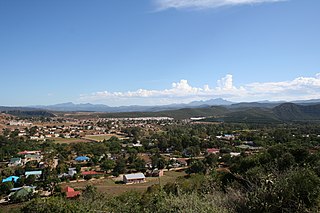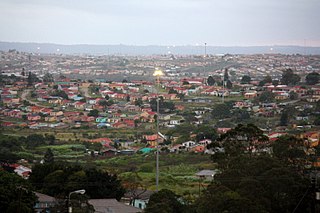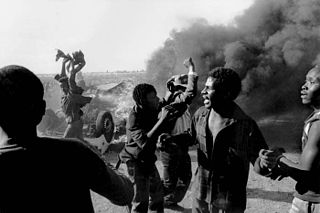
East London is a city on the southeastern coast of South Africa, in the Buffalo City Metropolitan Municipality, Eastern Cape Province. The city lies on the Indian Ocean coast, largely between the Buffalo River and the Nahoon River, and hosts the country's only river port. As of 2011, East London had a population of over 267,000 with over 755,000 in the surrounding metropolitan area.

In South Africa, the terms township and location usually refer to the often underdeveloped racially segregated urban areas that, from the late 19th century until the end of apartheid, were reserved for the non-whites, namely Black Africans, Coloureds and Indians. Townships were usually built on the periphery of towns and cities. The term township also has a distinct legal meaning in South Africa's system of land title, which carries no racial connotations.
Alexandra, informally abbreviated to Alex, is a township in the Gauteng province of South Africa. It forms part of the City of Johannesburg Metropolitan Municipality and is located next to the wealthy suburb of Sandton. Alexandra is bounded by Wynberg on the west, Marlboro and Kelvin on the north, Kew, Lombardy West and Lombardy East on the south. Alexandra is one of the poorest urban areas in the country. Alexandra is situated on the banks of the Jukskei River. In addition to its original, reasonably well-built houses, it also has a large number of informal dwellings or "shacks" called imikhukhu.
The following lists events that happened during 2002 in South Africa.
The following lists events that happened during 1987 in South Africa.

The Buffalo City Metropolitan Municipality is a metropolitan municipality situated on the east coast of the Eastern Cape province of South Africa. It includes the towns of East London, Bhisho and Qonce, as well as the large townships of Mdantsane and Zwelitsha.

Mdantsane is a South African urban township situated 15 km away from East London and 37 km away from Qonce in the Eastern Cape. It is the second largest township in South Africa after Soweto in Gauteng.
Cato Manor is a settlement located 7 kilometres (4.3 mi) from the city centre of Durban, South Africa.
Chief Botha Sigcau was a King in Eastern Pondoland, Transkei, South Africa (1939–1976) and later the figurehead President of Transkei from 1976 to 1978. A graduate of the University of Fort Hare, Sigcau was an early supporter of the Bantu Authorities in Transkei and was rewarded by the South African government when he was appointed chairman of the Transkei Territorial Authority, the parliament before independence.

The Landless People's Movement is an independent social movement in South Africa. It consisted of rural people and people living in shack settlements in cities. The Landless People's Movement boycotted parliamentary elections and had a history of conflict with the African National Congress. The Landless People's Movement was affiliated to Via Campesina internationally and its Johannesburg branches to the Poor People's Alliance in South Africa.
South Africa has been dubbed "the protest capital of the world", with one of the highest rates of public protests in the world.
The Constitution of South Africa protects all basic political freedoms. However, there have been many incidents of political repression, dating back to at least 2002, as well as threats of future repression in violation of this constitution leading some analysts, civil society organisations and popular movements to conclude that there is a new climate of political repression or a decline in political tolerance.

On 18 July 1983, Mdantsane and East London communities embarked on a bus boycott to protest an unannounced five cent increase in bus fares. The residents abandoned the partly Ciskei government-owned Ciskei Transport Corporation (CTC) buses for taxis and trains. On 4 August 1983, the Ciskei police tried to prevent residents from taking the train at Egerton train station in Mdantsane. After hesitating, the crowd advanced a few paces. However, as the police drew their guns, the people stopped. Without warning, the police fired into the crowd killing 11 and injuring 36 commuters, leading to what is now known as the Egerton railway station bus boycott massacre, the Mdantsane bus boycott massacre, the Egerton massacre, and similar terms.

On 21 March 1985, on the 25th anniversary of the Sharpeville massacre, members of the South African Police opened fire on a crowd of people gathered on Maduna Road between Uitenhage and Langa township in the Eastern Cape, South Africa. The crowd had been attending a funeral of one of the six who had been slain by the apartheid police on 17 March 1985. They had gathered at Maduna Square and were heading towards the house where the funeral was held when the police blocked the road with two armoured vehicles and ordered the crowd to disperse. When the crowd failed to comply immediately, police opened fire on the crowd, killing 35 people and leaving 27 wounded. The incident became known as the Uitenhage/Langa massacre.

On 17 November 1985, 2000 residents from Mlungisi township in Queenstown, Eastern Cape, gathered in Nonzwakazi Methodist Church to hear back from the Local Residents Association, who, in early November, had met with the Department of Education and Training, the Queenstown municipality, the Eastern Cape Development Board, and the Queenstown Chamber of Commerce to discuss the end of the consumer boycott. The meeting was short-lived as members of the Queenstown branch of the South African Police stormed into the meeting and opened fire on the residents. In the ensuing conflict between police and residents, 14 people were shot dead and 22 were injured. This incident is known as the 1985 Queenstown Massacre.
Alcott Skwenene 'Skei' Gwentshe was a shopkeeper, musician and political activist who helped establish an African National Congress Youth League (ANCYL) branch in East London. He was among the political activists banished under the Native Administration Act of the South African Apartheid government.
Elsie Quinlan, religious name Mary Aidan, was a Dominican sister who was killed in Duncan Village in 1952, by a mob of ANC rioters.
Donald Card was a South African security constable and politician who was the Mayor of East London, South Africa.
Bus boycotts in South Africa were a series of protests that took place in the Union of South Africa and in the present Republic of South Africa against increasing prices of transport fees and segregating practices during the Apartheid to the present.

The Vaal uprising was a period of popular revolt in black townships in apartheid South Africa, beginning in the Vaal Triangle on 3 September 1984. Sometimes known as the township revolt and driven both by local grievances and by opposition to apartheid, the uprising lasted two years and affected most regions of the country. The government of P. W. Botha did not succeed in curbing the violence until after it imposed a national state of emergency in June 1986.









